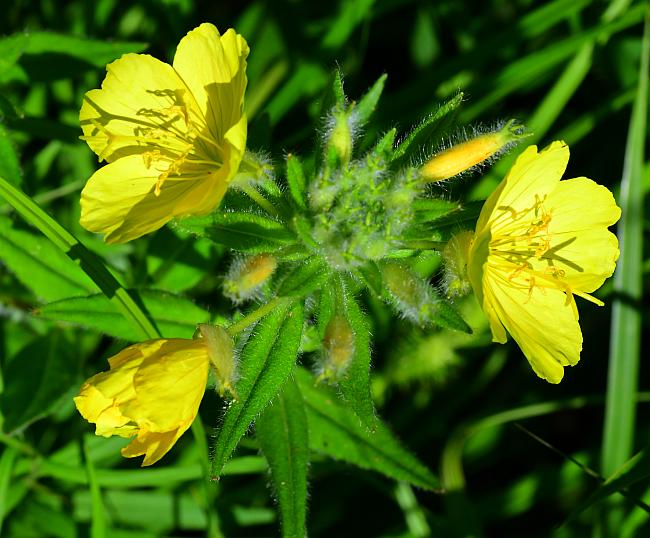Oenothera pilosella Raf.
Sundrops

Native
CC = 6
CW = 0
MOC = 13
© SRTurner
Oenothera pilosella Raf.Sundrops | |
 |
Native CC = 6 CW = 0 MOC = 13 |
© SRTurner |
|
Family - Onagraceae Habit - Rhizomatous, perennial forb with a thickened rootstock. Stems - Ascending to erect, to 80 cm (including the inflorescence), solitary to a few, unbranched or with few to several branches, sparsely to densely pubescent with spreading, nonglandular hairs 1-2 mm long, rarely glabrous.
Leaves - Basal and alternate, simple, petiolate. Basal leaves overwintering and usually withered at flowering; rosette leaves 4-8 cm long, 2-5 mm wide, lanceolate to ovate, short-to moderately petiolate, the margins entire or the broader ones coarsely toothed, hairy, the surfaces nonglandular-hairy, rarely glabrous. Stem leaves 2-10 cm long, 10-20 mm wide, mostly lanceolate, occasionally linear or ovate, mostly short-petiolate, the margins entire or slightly irregular to coarsely toothed, hairy, the surfaces nonglandular-hairy, rarely glabrous, the secondary veins usually relatively conspicuous.
Inflorescences - Open spikes, not grouped into panicles, usually relatively short and sometimes few-flowered, the portion in bud erect, the axis usually moderately to densely pubescent with relatively long, spreading, nonglandular hairs. Bracts relatively conspicuous, 5-45 mm long, 1-10 mm wide, linear to lanceolate.
Flowers - Actinomorphic, opening in the morning, the floral tube 10-25 mm long, usually spreading-hairy. Sepals 10-20 mm long, with spreading to appressed, nonglandular hairs, the free tips in bud 1-4 mm long, usually somewhat spreading. Petals 15-30 mm long, 15-25 mm wide, broadly obovate to somewhat heart-shaped (broadly but sometimes shallowly notched at the tip), lacking a stalklike base, yellow to deep yellow, fading to yellow or lavender. Stamens with the filaments 7-15 mm long, ascending, glabrous at the base, the anthers 4-8 mm long, yellow. Style 10-20 mm long, the stigma positioned well above the anthers, deeply 4-lobed, the lobes 2-5 mm long.
Fruits - Capsules 10-15 mm long, the main body longitudinally dehiscent toward the tip and eventually most of the length, 4-locular, 10-14 mm long, 2-4 mm in diameter, narrowly club-shaped to ellipsoid, not flattened, strongly 4-angled or rarely slightly 4-winged, the surfaces glabrous to densely pubescent with appressed or spreading, nonglandular hairs, sessile or tapered to an indistinct, sterile, stalklike base to 2 mm long, this also glabrous or hairy. Seeds numerous in each locule, clustered and not in definite rows, 0.8-1.0 mm long, 0.3-0.5 mm wide, irregularly rhombic-ellipsoid to prismatic-ovoid, the surface dark reddish brown, pebbled. Self-incompatible.
Flowering - May - July. Habitat - Fens, marshes, swamps, wet prairies, ditches, fields, railroads, and roadsides. Also cultivated. Origin - Native to the U.S. Lookalikes - O. fruticosa; more broadly, several other species of Oenothera. Other info. - This attractive species is not particularly common. In Missouri it is found in scattered counties in the eastern half of the state. More broadly, its range describes an arc from Louisiana north and east to New York. The many species of Oenothera can look similar. For O. pilosella, important identifying characters include the large, bright yellow flowers, the 4-lobed stigma elevated well above the anthers, and the club-shaped and 4-angled fruits. Photographs taken at Shaw Nature Reserve, Franklin County, MO, 6-5-2021 (SRTurner). |